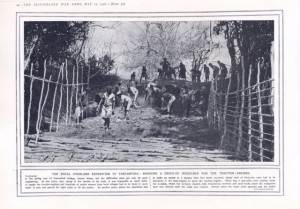by John Sankey
As the centenary of the 1914 -18 War is being commemorated, several items relating to the East African campaign have recently appeared at auctions.
The most interesting is the Distinguished Service Cross (DSC) and other medals awarded to Lieutenant Arthur Dudley RNVR, who commanded the gunboat Toutou during the famous Lake Tanganyika expedition. This led to the sinking of two German warships and was the inspiration for the film African Queen.
Dudley had qualified as a Second Mate in the Merchant Navy before enlisting in the Army and serving in the Boer War. He settled in Northern Rhodesia and in 1915 he was ‘head-hunted’ for the Lake Tanganyika expedition. Commissioned as a Lieutenant in the Royal Naval Volunteer Reserve and ordered to report to Cape Town, he was given the task of organising the transportation of the gunboats HMS Mimi and HMS Toutou over several thousand miles to Lake Tanganyika. The train journey, to Elisabethville (Lubumbashi) in the Belgian Congo, was relatively easy; but the final 150 miles to the lake were on jungle tracks, with the boats hauled by steam tractors, ox-trains or human labour. Dudley was mentioned in despatches as it was ‘due to his exertions that the transport of the boats was successfully accomplished’.

HMS Mimi on Lake Tanganyika being pushed off a sand bank – The Illustrated War News 1916 from www.africanbyways.co.za

Bridging a riverbed while transporting HMS Mimi & Toutou to Lake Tanganyika – The Illustrated War News 1916 from www.africanbyways.co.za
Mimi and Toutou reached the lake in December 1915 and went into action immediately. The German vessel Kingani was captured and re-named HMS Fifi, and in February 1916 the British flotilla sank the Hedwig von Wissman. The captain of the German flagship Graf von Goetzen decided to scuttle his vessel at Kigoma to avoid possible capture.
The success of the Lake Tanganyika expedition made headlines in England and raised morale at a time when the War was going badly elsewhere. George V sent his personal congratulations, the commanding officer (Commander Spicer-Simson) was awarded the DSO and his two lieutenants (Dudley and Wainwright) were awarded the DSC. After the War, Dudley returned to Northern Rhodesia and died in Lusaka in 1942. His medals fetched £10,000.
The second group of medals includes the Distinguished Service Medal (DSM) awarded to Yeoman of Signals Daniel Greenshields, serving on HMS Severn. In July 1915 the Severn entered the Rufiji Delta and engaged the Konigsberg, her gunfire being directed by a spotter aircraft – one of the first examples of ground/air cooperation in naval history. The German cruiser was set ablaze and put out of action.
The Severn then sailed to Tanga and sank the German blockade runner Markgraf. On returning to the Rufiji, the Severn was ordered to destroy a German observation post left behind by the Konigsberg at Simba Uranga. Greenshields was a member of the landing party and had a narrow escape when the German signaller fired at him at point-blank range – and missed. He was awarded the DSC in July 1916. His medals were sold for £5,200.
The third group of medals was awarded to Rear-Admiral Hector Boyes CMG. Boyes was in command of the gunboat HMS Thistle when Dar es Salaam was captured in 1916 and then took part in a combined operation at Lindi with HMS Severn to destroy a German strongpoint equipped with a 4.1” gun salvaged from the Konigsberg. A shell from this gun hit the Thistle, killing one sailor and setting fire to the magazine, fortunately extinguished by the bravery of the crew. Shortly afterwards the landing party occupied the German position and captured the gun. Boyes was awarded the CMG for this action.
In July 1918 the Thistle took part in a combined operation at Quelimane (Portuguese East Africa, now Mozambique) which forced von Lettow– Vorbeck back over the Ruvuma. For this Boyes was awarded the Portuguese Military Order of St Aviz. His fifteen medals were sold for £5,000.
Finally, an unusual hand-painted china plate was auctioned, depicting a Zeppelin airship flying over the Pyramids and inscribed ‘Afrika Schiff L 59 1917’. This commemorates an ingenious plan by the Germans to beat the British blockade by sending supplies to von Lettow by air, a novel idea in 1917. The amount of cargo carried was relatively small, but the plan was to dismantle the airship on its arrival at Mahenge (south of Morogoro), so that the canvas, metal struts etc could be used by von Lettow’s troops. The propaganda value would also be immense. In the event, the airship was over Sudan when it was ordered to return to Germany, as von Lettow had been forced to withdraw from Mahenge and the airship might be captured. The plate fetched £260.
John Sankey (with thanks to Dix Noonan Webb and Wallis & Wallis)
